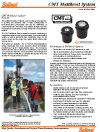Model 403 CMT Multilevel Groundwater & Vapor Monitoring Systems


| Size/Type | Part Number | Price | |
|---|---|---|---|
| 1.7″ 7 Channel System | TBD | TBD | Order » |
| 1.1″ 3 Channel System | TBD | TBD | Order » |
(4pg, 1.1MB)
Target remediation strategies effectively and accurately with the Model 403 CMT Multilevel Groundwater & Vapor Monitoring System by Solinst. This multilevel system is easy to install and minimizes site disturbance. The CMT Multilevel System is available in a 1.7" OD polyethylene tubing that is segmented into 7 channels or the 1.1" OD polyethylene tubing that is segmented into 3 channels.
Why you should be using and multilevel system
Traditional methods of groundwater monitoring can be inaccurate due to cross contamination, masking the true contaminant concentrations and distribution. Multilevel systems with short-screened intervals solve this problem, providing the most precise three-dimensional data of the site. This makes monitoring contaminate plumes more economical. Plus the CMT Multilevel System provides horizontal and vertical data. The zones can be put where needed and reliable seals are achieved between zones.
Advantages
- Provide the most accurate 3-D assessment of a site
- Vital to understanding vertical contaminant distribution
- Allow documentation of changes in the concentration and delineation of contaminant plumes
- Low cost compared to multiple individual wells
- Minimize site disturbance
Applications
- Identify vertical as well as horizontal contaminant distribution with transect monitoring
- Ideal for shallow wells in high water table environments
- Multilevel water sampling and level monitoring in unconsolidated soils or bedrock
- Dewatering impact assessments at construction & mining sites
- Mass transport calculations and mass flux estimation
- Monitoring of natural attenuation or remediation processes, and documentation of its effectiveness
- VOC, MTBE and Perchlorate monitoring at NAPL sites
- Determination of the best location for reactive barrier walls, the Waterloo Emitter and other remediation methodologies
- Vapor monitoring with special wellhead seals
- Helps optimize design and performance assessment of remedial options

